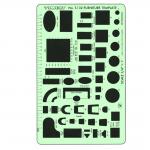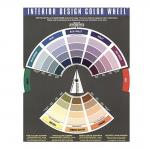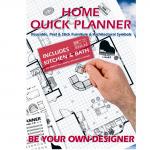Furniture Terms from A - C
The Whole Truth & Nothing but the Truth! There are links and ads on this site that pay us a commisson if you "click" and purchase something. This helps us to keep the lights on and continue to provide free content. Thanks! Now you may continue reading!
Accent Furniture: Any furniture that is designed for occasional use or decorative purposes in a room. Accent furniture is often a lady’s chair, small table, or small display cabinet.
Apron or Skirt: This is simply a strip of wood, usually, about three inches wide that runs around the bottom of a tabletop or chair seat. It is mounted between the legs and helps to hide nasty looking things like table slides. Skirts are also useful in keeping arm chairs from fitting under the table and snagging dresses, pants etc.
Area Rug: A rug that is smaller than the room that it is in. It may be an accent for the room or it may be used to cover up stains or worn spots in carpet. Area rugs are often used to soften hard floors.
Armoire: Literally, a case to store armor and weapons. Most homes, in centuries past, did not have much in the way of closet space so the armoire served that function. The armoire is a tall cabinet with two doors, hanger rod, and sometimes shelves. In modern times, armoires have been used to house televisions and related electronics.
Arrow Foot: A leg on a table or sometimes a chair, that tapers down to the floor and is separated by a turning from the upper portion of the leg.
Art Décor: Any artistic addition to a room that enhances or brings out an element of design in the room.
Attached Cushion: This term usually refers to a seat or back cushion in a chair, loveseat or sofa that is attached to the body of the furniture. The advantage is that the piece retains its tidy appearance even after someone has been sitting in it. The disadvantage is that the cushions cannot be turned, rotated or even removed for cleaning.
Baby Furniture: This general term is applied to any furniture that is specifically designed to be used by a baby. Most baby furniture is scaled down from adult furniture proportions in order to meet the demands of smaller secondary bedrooms. Any furniture that is manufactured in or for sale in the United States must meet certain safety standards. For example, the finish must be non-toxic and the spacing between slats in a crib must not exceed a certain distance.
Bachelor’s Chest: Technically, a bachelor’s chest could be defined as the floor and door knobs in any room in a house. The furniture that is described by this term is a short chest of drawers with three to four drawers. These pieces will usually have drawers that are graduated in height. True bachelor’s chests will have a pullout, flip down or inclined top that serves as a writing desk when needed. The modern bachelor’s chests do not usually have this feature but may have two doors at the top for storage.
Baguette: A convex semi-circular molding.
Bail: This is a style of drawer pull that hangs down from the backing plates that hold the screws. This style of pull is usually a pretty standard three inch center (from the middle of one mounting hole to the other) Always measure though, if you are changing out your hardware. You’ll be pretty red faced if you drill your holes three inches on center and the pulls are three and a half inches. This style of pull tends to dangle freely from the screw mounts forcing small children to stand there flicking the handles up and letting them fall noisily to the drawer front.
Ball Foot: This commonly used style of furniture foot comes in several varieties that are, sometimes indistinguishable from each other. There is a simple ball with a design at the top. Then you have the ball and claw. The ball and claw is usually carved to look like an eagle’s talon wrapped around the ball. Last is the nondescript claw that has little or no detail or definition because that would cost more to do.
Banquette: The true definition of this term is an upholstered bench or settee according to Furniture Facts. I have heard other styles of benches, usually a wrap around bench that is part of a corner style dining table group. I have also heard people refer to any built in bench as a banquette. Who am I to judge. Our language continues to evolve.
Baroque: An Italian style of furniture that is very ornate from the 1700s. This is a style that you have to seek out these days so, if you want it, you already know what it is.
Barrel Back Chair: This style of chair combines the arms and back into a single curved unit, giving the appearance of a barrel.
Bombe: This style looks like me after Thanksgiving dinner. The front swells outward. It is most commonly pronounced and, sometimes spelled, b-o-m-b-a-y. In all likelihood, this is incorrect. This will only matter if you are writing to somebody to tell them about your new furniture and they know the correct spelling.
Birdseye: Oops, I went out of order. None the less, these small markings are most commonly found in sugar maple. They appear to be very small knots in the shape of, you guessed it, the eye of a bird. Just in case you aren’t aware, these marks are desirable and add to the interest of the piece that they are in. They are not defects.
Boston Rocker: This uniquely American rocker was popular in the 19th century and enjoyed a comeback in the last half of the 20th century. The seat is deeply dished. The back has curved spindles and a bent top.
Bowback Chair: The back of these chairs consists of wood bent in the shape of a bow. Spindles that are either turned or shaped somewhat like a bent arrow (in which case the chair is referred to as an arrowback) are inserted vertically in the seat and the inside of the bow.
Bowfront: A front that curves out uniformly from top to bottom. Unlike the Bombe style the bulge is not tapered back on the top and bottom of the front.
Brass: Brass is an alloy of copper and zinc. Solid brass refers to something that is made entirely from brass. This is not to say that the object made from brass may not be hollow. Many years ago, I was working with a customer that could not get his arms around the concept that a large solid brass goose that I was selling was hollow in its center. The term solid brass differentiates something that is all brass from something that is a different material plated with brass.
Breakfront: This term has come to mean anything from a china hutch in which the middle bows out, to a three piece bookcase with a drop front desk built into the middle. If the piece consists of a drop front desk with a tall mirrored back attached to a curio or bookcase, this is called a secretary.
Brewster Chair: The Brewster Chair was designed in the early Seventeenth Century by William Brewster, one of the original band of Pilgrims that landed in present day Massachusetts in 1620. The chair is massive, angular and busy. The multitude of turned spindles in the base, back and arms is almost dizzying. Many more chairs in this general style were turned out in the Seventeenth Century but few have survived.
Bunk Bed: Designed in the mid-Twentieth Century, these beds made it possible for two people to share a room without sharing a bed. The design maximized available floor space.
Buffet: A true buffet is much like the base of a china hutch except that it is usually higher and has a backsplash. A buffet is shallower front to back and usually a little shorter than a hunting table. It is designed to hold dishes, silverware and table linen.
Bun foot: A foot that looks like somebody stepped on ball and flattened the top and bottom. The top of the foot tapers up to a small neck that attaches to the frame of the piece.
Bureau: Similar to a chest of drawers but usually taller and perhaps slightly wider. Some bureaus have a gallery of smaller drawers on top.
Burl: A large tree knot or a bulge, similar to a goiter, that is usually sliced thin for veneer. These cuts are somewhat rare making the burl or burr very expensive.
Butterfly Table: This type of table has a leaf that is permanently attached to the table top. The leaf is split in the middle and hinged. The leaf skirts are hinged too so that they fold up. When the leaf is folded, the special hinges allow it to be folded beneath the tabletop in a way that allows the top to be closed. The leaves are sometimes called self storing leaves. Another form of self storing is a standard table leaf. The bottom of the tabletop is designed so that the leaf may be taken out of the table, turned and stored under the top when it is closed.
Failure to plan is the most common furniture mistake. Be sure to check out the wide selection of furniture space planners, color wheels and furniture templates available from Furniche.com
Cabinet: A case piece designed to store or display items such as dining ecroutement or collections. Example: Linen and silverware, thimble collections or guns.
Cabriole: This is a leg style dating to the 1700s. The top of this leg is usually somewhat beefy with an outward curve, tapering down to a narrow inward curve. This style may be very plain or very ornate.
Camelback: This sofa design has a pronounced but graceful rise in the middle of the back. There is another version called the reverse camelback that has a hump at each end with a dip in the middle.
Camel Back Sofa: A camel back sofa has two humps on the back. This style is differentiated from the Victorian sofas with one hump in the middle and is characteristic of the Hepplewhite designs.
Cane or Caning: A chair back or seat that is made of narrow strips of cane woven together. The cane was usually woven into a fine pattern, cut to fit the opening in the seat or back of the chair and then held in place by a strip of came that was gently pounded into a groove cut next to the opening.
Canopy: Fabric hung between the tall posts of a bed and suspended from rails between the posts. Canopies were originally designed to protect the occupant of the bed from drafts, light and insects. They are mostly decorative today.
Canted: A surface, usually at the top of piece of furniture, that is angled outward at approximately forty-five degrees from vertical.
Capital: The top supporting piece of a column.
Casegoods: Any piece of wood furniture made to store things.
Chair Rail: A piece of molding that goes around a room, usually a dining room, at the approximate height of a chair back. The purpose is to minimize damage to a wall from chair backs hitting it. Today, they are mostly decorative.
Checking: Small openings in the grain of wood usually caused by improper kiln drying of the wood. If the moisture content of the wood is too high, the wood will pull apart slightly as it dries.
Chipboard: Formed wood made up of small chunks of wood. The wood is not ground as finely as that used in MDF. The chips of wood are mixed with glue and formed, usually into 4’ x 8’ sheets. This product is used, most often, in construction and in the cheapest furniture. It is not ideal for furniture and doesn’t hold up well in the long run.
Coffee or Cocktail Table: A long low table designed to be a convenient height and size to place beverages on. Chaise Lounge: This is a type of seating that allows the person using it to sit with their legs extended in front of them.
Coil Springs: A type of spring made from spiraling tempered steel wire. It is used in mattresses, seat cushions and seating frames. The coil count in mattresses has gone from a reasonable measurement of the support and strength of a mattress to, in many cases, a useless misrepresentation similar to Manufacturer’s Suggested Retail Price. Research mattresses carefully online before buying.
Chest of Drawers: A case that has drawers and occasionally, doors and shelves. This piece is taller and narrower than a dresser. There are a number of variations that we will cover later.
Cheval Mirror: A long mirror that is mounted in an adjustable stand that swivels to give the person using it a full view of their outfit.
Chiffonier: A vanity or a tall dresser originally designed with a lady’s needs in mind. A dressing table.
Comb Back Chair: A comb back chair is an early Windsor style which uses long spindles that go from the bent arm rail on the back of the chair to a headrest. The appearance of the chair back looks like a comb that a lady would put in her hair to hold it in place.
Commode: A small table or cabinet with doors. In the good old days, the chamber pot was kept behind the doors for the sake of discretion. Maybe the good old days aren’t so good after all.
Concave: Curving toward the back of a leg or drawer front. Convex: Curving toward the front of the structure.
Corner Block: This is a triangle of wood that is glued into the corner of a case piece or the bottom corners of a drawer. Its function is to give the frame or box added strength.
Crazing: Tiny interwoven cracks in the finish on wood. This can happen if the underlying wood was not properly cured or if the material used to finish the piece was improperly blended. Crazing will usually result in chipping and peeling of the finish over time.
Credenza: A long low cabinet with file drawers in the center and shelves at the ends. Most often used behind a large desk
Curly Maple: This cut of maple gives the grain a curly or flame type appearance. The grain seems to undulate or wave across the wood.
Cupboard: As the spelling implies, these were cabinets designed to hold cups and other dinnerware. The term, as used in modern times, has come to mean any storage piece with doors, whether built in or freestanding.






